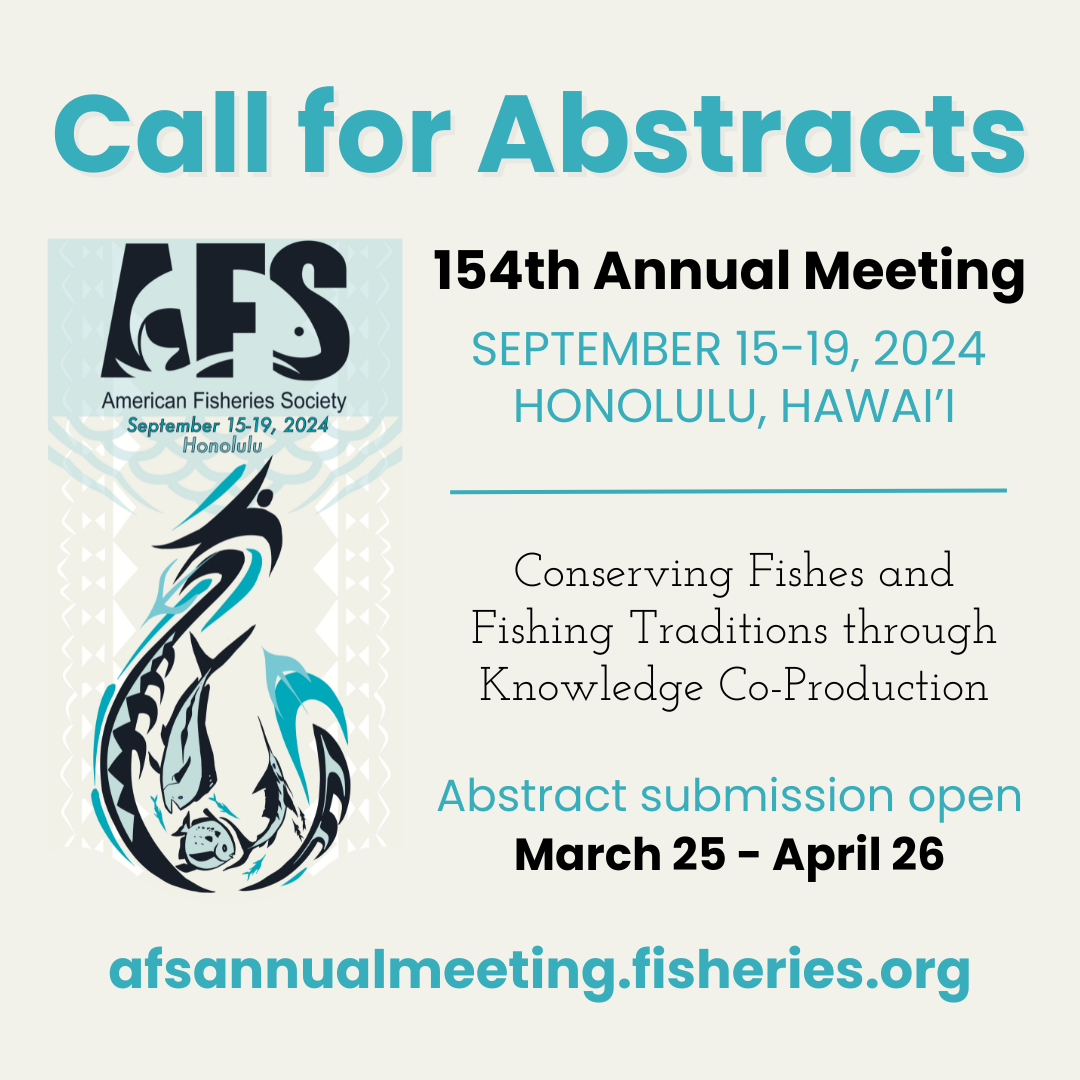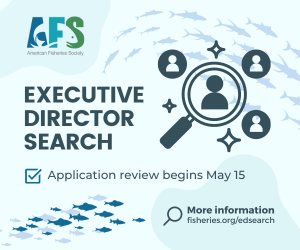February 7, 2023
Chairman David Rouzer
U.S. House of Representatives
Committee on Transportation and Infrastructure
Subcommittee on Water Resources and Environment
2165 Rayburn House Office Building
Washington, DC 20515
Ranking Member Grace Napolitano
U.S. House of Representatives
Committee on Transportation and Infrastructure
Subcommittee on Water Resources and Environment
2165 Rayburn House Office Building
Washington, DC 20515
Dear Chairman Rouzer and Ranking Member Napolitano:
On behalf of the American Fisheries Society (AFS), thank you for the opportunity provide testimony on the impacts of the Biden Administration’s Waters of the United States (WOTUS) rule (2023 Rule) published in the Federal Register on January 18, 2023.
AFS is the world’s oldest and largest professional society of fisheries and aquatic scientists and managers. The Society seeks to improve the conservation and sustainability of fisheries and aquatic ecosystems by advancing science and promoting the development of fisheries professionals. We greatly value the country’s clean waters and healthy aquatic ecosystems as they are critical to maintaining fisheries and other critical ecosystem services such as supporting biodiversity, flood control, and carbon storage.
The mandate of the Clean Water Act is to restore and maintain the chemical, physical, and biological integrity of the nation’s waters. This can only be achieved if the definition of WOTUS is grounded in sound science that recognizes the multiple dimensions of waterbody connectivity: physical/hydrologic, chemical, and biological.
AFS has long supported a science-based definition of WOTUS. The 2023 Rule, seeks to balance the science with efficiency and provides additional clarity for implementation of the rule. We oppose returning to the 2020 Navigable Waters Protection (2020 NWPR) rule. The limited protections in the 2020 NWPR threaten highly valued fish, fisheries, ecosystem services, and the communities that rely on them (Colvin et al. 2019). The 2020 NWPR removes protections for millions of miles of headwater streams and millions of acres of wetlands and would result in severe ecological and economic losses and cause irreparable cultural and social damage (Cohen et al. 2016; Fesenmyer et. al. 2021; Creed et. al. 2017; Sullivan Declaration 2020.)
More than a half century of scientific research demonstrates that the integrity of “traditionally navigable” waters fundamentally depends on tributaries – including headwater ephemeral, intermittent, and perennial streams – as well as many associated lakes, wetlands, and off-channel habitats (USEPA, 2015). Aquatic ecosystems depend upon transfers of chemical components, organisms, sediment, and organic materials among waterbodies to support the life in and around their shores. Without the safeguards of the Clean Water Act for these streams and wetlands, the ability of these waters to convey nutrients, provide pathways for migrating organisms such as fish and wildlife, and serve as a drainage and storage system for floodwaters is severely undermined.
AFS fully supported the 2015 Clean Water Rule (2015 CWR) because it was based on the demonstrated importance of the many physical, chemical, and biological connections of headwaters to the ecological condition of downstream and downslope navigable waters and their biota. The 2015 CWR was informed by the best scientific information available as set forth in the comprehensive scientific report that accompanied the rule, i.e., the “Connectivity of Streams and Wetlands to Downstream Waters: A Review and Synthesis of the Scientific Evidence” (herein the “Connectivity Report” but described in the 2015 CWR as the “Science Report”). The Connectivity Report synthesized over 1,200 peer-reviewed publications and provided the technical basis for the 2015 CWR. In the intervening years, interdisciplinary scientific efforts have further demonstrated the importance of protecting non-permanent waterbodies, including intermittent and ephemeral headwater streams and wetlands that are hydrologically and biologically connected to navigable waters (e.g., Cohen et al. 2016, Rains, et al. 2016, Fritz et al. 2018, Harvey et al. 2018, Leibowitz et al. 2018, Schofield et al. 2018, Colvin et al. 2019).
In contrast, the 2020 NWPR was not based on current science and reversed decades of protections that were put in place to ensure clean water would be available for future generations (Sullivan et al. 2019, Sullivan et al. 2020). The 2020 NWPR rule focused only on hydrological surface connections to establish jurisdiction. It ignored many key biological and chemical connections that are critical for fully functioning aquatic ecosystems. It only recognized a limited subset of connectivity conditions, and it relied on flow permanence and physical abutment as measures of jurisdiction. Hence, it arbitrarily ignored other ecologically critical aspects of physical connectivity such as bed, banks, and high-water marks, and chemical, biological and ecological connectivity that were incorporated in the 2015 CWR.
The 2020 NWPR eliminated protections for a staggering number of headwater streams, which are broadly defined as portions of a river basin that contribute to the development and maintenance of downstream navigable waters including rivers, lakes, and oceans. Headwaters include wetlands outside of floodplains and small streams with permanent flow, intermittent flow, and ephemeral flows. Headwaters affect downstream and downslope streams and wetlands; that is, they are hydrologically, chemically, physically, biologically and ecologically connected to what happens downstream.
Headwaters are key to the sustainability of fish stocks in both upstream and downstream waters and should be protected (Colvin et al., 2019). The loss of Clean Water Act protections for headwaters would diminish ecosystem services provided by those waters, increase threats to imperiled species, impair commercial and recreational fisheries in both fresh and salt waters, and degrade fishes of great cultural value to Native Americans and the recreating public.
Climate change will only exacerbate those losses. Aquatic resources in many states, particularly in the central and western U.S., are already stressed by overuse of water and extreme weather patterns. The reduction in groundwater has greatly impaired flow regimes, causing many streams to shift from perennial to intermittent or even ephemeral (Colvin et al., 2019). Under the 2020 NWPR rule, streams and playas may no longer be protected that were historically perennial but now have impaired flows because of groundwater depletion. Whereas water rights and use largely fall outside the jurisdiction of the Clean Water Act, the negative impacts of unregulated dredge and fill within those streams and playas would amplify the current stresses faced by aquatic ecosystems and further reduce the potential for habitat recovery. Such cumulative impacts increase the likelihood of future listings and extinctions of fish, amphibians and waterfowl, thereby jeopardizing the ecological integrity and function of our waters.
In addition to the loss of protection for headwaters, the 2020 NWPR seeks to eliminate protections for wetlands that do not abut or have a direct hydrologic surface connection to other WOTUS. Wetlands provide essential ecosystem services such as protection of drinking water quantity and quality, provision of floodwater and carbon storage, storm damage mitigation, resilience against sea-level rise and drought, and essential fish, shellfish, waterfowl, and wildlife habitat. Wetland loss in some regions of the U.S. already approaches or exceeds 85 percent. As documented in the Connectivity Report, wetlands that neighbor other WOTUS, but are not necessarily abutting or having a direct hydrologic surface connection in a typical year, often exhibit functional connections with other WOTUS, and should be protected. These waters equal the size of West Virginia and the loss of ecosystem services they provide would be staggering.
The 2023 Rule is a vast improvement over the 2020 NWPR and represents a step forward in protecting our Nation’s waters and the critical ecosystem services they provide for people and the environment. It appropriately recognizes that science is complex and cannot be ignored for the convenience of administering the Clean Water Act. The 2023 Rule addresses the major flaws with the 2020 NWPR, seeks to balance the science with efficiency, and provides additional clarity for implementation. It considers the science as established in the Connectivity Report as well as more recent research on waterbody connectivity. Further, the 2023 Rule takes a first step at addressing climate change in the context of federal water protection. Notably, the 2023 Rule states that science does not provide bright lines relative to defining a specific distance required for adjacency, and clearly outlines those waters that constitute exclusions from jurisdiction. The 2023 Rule defines the geographic scope (i.e., in the region) for purposes of significant nexus analysis. It also clarifies that wetland complexes (i.e., two or more individual wetland areas that are functionally related and geographically clustered) are to be considered in the aggregate.
To more fully protect aquatic resources, we recommend that future rule revisions provide protections to ensure chemical and biological connectivity as well as groundwater protections.
In closing, we urge you to uphold the 2023 Rule and not return to the 2020 NWPR for the significant harm it would cause to wildlife, fish, fisheries and the communities that rely on them. Thank you for the opportunity to comment. We are willing to assist should you need additional information or consultation.
Sincerely,
Douglas J. Austen, Ph.D.
Executive Director
American Fisheries Society
References
Cohen, M. J., I. F. Creed, L. Alexander, N. B. Basu, A. J. K. Calhoun, C. Craft, E. D’Amico, E. DeKeyser, L. Fowler, H. E. Golden, J. W. Jawitz, P. Kalla, L. K. Kirkman, C. R. Lane, M. Lang, S. G. Leibowitz, D. B. Lewis, J. Marton, D. L. McLaughlin, D. M. Mushet, H. Raanan-Kiperwas, M. C. Rains, L. Smith, and S. C. Walls. 2016. Do geographically isolated wetlands influence landscape functions? Proceedings of the National Academy of Sciences of the United States of America 113:1978–1986.
Colvin, S. A. R., S. M. P. Sullivan, P. D. Shirey, R. W. Colvin, K. O. Winemiller, R. M. Hughes, K. D. Fausch, D. M. Infante, J. D. Olden, K. R. Bestgen, R. J. Danehy, and L. Eby. 2019. Headwater streams and wetlands are critical for sustaining fish, fisheries, and ecosystem services. Fisheries 2:73–91.
Creed, I. F., C. R. Lane, J. N. Serran, L. C. Alexander, N. B. Basu, A. J. K. Calhoun, J. R. Christensen, M. J. Cohen, C. Craft, E. D’Amico, E. DeKeyser, L. Fowler, H. E. Golden, J. W. Jawitz, P. Kalla, L. K. Kirkman, M. Lang, S. G. Leibowitz, D. B. Lewis, J. Marton, D. L. McLaughlin, H. Raanan-Kiperwas, M. C. Rains, K. C. Rains, and L. Smith. 2017. Enhancing protection for vulnerable waters. Nature Geoscience 10:809–815.
Declaration of Dr. S. Mažeika Patricio Sullivan, California v. Wheeler (N.D. Cal.), Case 3:20-cv-03005-RS, Document 30-18.
Fesenmyer, K.A., H.M. Neville, S.J. Wenger, and D. Leigh, Large portion of USA streams lose protection with new interpretation of clean water act. Freshwater Science, February 2021.
Fritz, K. M., K. A. Schofield, L. C. Alexander, M. G. McManus, H. E. Golden, C. R. Lane, W. G. Kepner, S. D. LeDuc, J. E. DeMeester, and A. I. Pollard. 2018. Physical and chemical connectivity of streams and riparian wetlands to downstream waters: a synthesis. Journal of the American Water Resources Association 54:323–345.
Harvey, J., J. Gomez-Velez, N. Schmadel, D. Scott, E. Boyer, R. Alexander, K. Eng, A. Kettner, C. Konrad, R. Moore, J. Pizzuto, G. Schwarz, C. Soulsby, and J. Choi. 2018. How hydrologic connectivity regulates water quality in river corridors. Journal of the American Water Resources Association 55:369–381.
Hughes, R. M., J. N. Rinne, and B. Calamusso. 2005. Historical changes in large river fish assemblages of the Americas: a synthesis. Pages 603–612 in J. N. Rinne, R. M. Hughes, and B. Calamusso, editors. Historical changes in large river fish assemblages of the Americas. American Fisheries Society, Symposium 45, Bethesda, Maryland.
Leibowitz, S. G., P. J. Wigington, K. A. Schofield, L. C. Alexander, M. K. Vanderhoof, and H. E. Golden. 2018. Connectivity of streams and wetlands to downstream waters: an integrated systems framework. Journal of the American Water Resources Association 54:298–322.
Leprieur F., O. Beauchard, S. Blanchet, T. Oberdorff, and S. Brosse. 2008. Fish invasions in the world’s river systems: when natural processes are blurred by human activities. PLoS Biol 6(2):e28. doi:10.1371/journal.pbio.0060028
Perkin, J. S., K. B. Gido, J. A. Falke, K. D. Fausch, H. Crockett, E. R. Johnson, and J. Sanderson. 2017. Groundwater declines are linked to changes in Great Plains stream fish assemblages. Proceedings of the National Academy of Sciences of the United States of America 114:7373–7378.
Rains, M. C., S. G. Leibowitz, M. J. Cohen, I. F. Creed, H. E. Golden, J. W. Jawitz, P. Kalla, C. R. Lane, M. W. Lang, and D. L. McLaughlin. 2016. Geographically isolated wetlands are part of the hydrological landscape. Hydrological Processes 30:153–160.
Schofield, K. A., L. C. Alexander, C. E. Ridley, M. K. Vanderhoof, K. M. Fritz, B. C. Autrey, J. E. DeMeester, W. G. Kepner, C. R. Lane, S. G. Leibowitz, and A. I. Pollard. 2018. Biota connect aquatic habitats throughout freshwater ecosystem mosaics. Journal of the American Water Resources Association 54:372–399.
Stoddard, J. L., D. V. Peck, A.R. Olsen, D. P. Larsen, J. Van Sickle, C. P. Hawkins, R. M. Hughes, T. R. Whittier, G. Lomnicky, A. T. Herlihy, P. R. Kaufmann, S. A. Peterson, P. L. Ringold, S. G. Paulsen, and R. Blair. 2005. Western streams and rivers statistical summary. EPA 620/R-05/006, U.S. Environmental Protection Agency, Washington, D.C.
Sullivan, S.M.P., Rains, M.C., Rodewald, Buzbee, W.W., and A.D Rosemond. 2020. Distorting science, putting water at risk. Science 369:766-768.
Sullivan, S.M.P., Rains, M.C., and A.D. Rodewald. 2019. The proposed change to the definition of “waters of the United States” flouts sounds science. Proceedings of the National Academy of Sciences 116(24):11558–11561.
U.S. Environmental Protection Agency. 2015. Connectivity of streams and wetlands to downstream waters: a review and synthesis of the scientific evidence (final report). U.S. Environmental Protection Agency, EPA/600/R-14/475F, Washington, D.C.
U.S. Environmental Protection Agency and U.S. Army Corps of Engineers. 2020. The navigable waters protection rule: definition of “waters of the United States.” Federal Register 85:77(21 April 2020):22250.
U.S. Army Corps of Engineers and U.S. Environmental Protection Agency. 2015. Clean water rule: definition of “waters of the United States.” Federal Register 80(29 June 2015):37054.
U.S. Environmental Protection Agency and U.S. Army Corps of Engineers. 2022. Clean water rule: definition of “waters of the United States.” Federal Register 88 (18 January 2023): 3004





